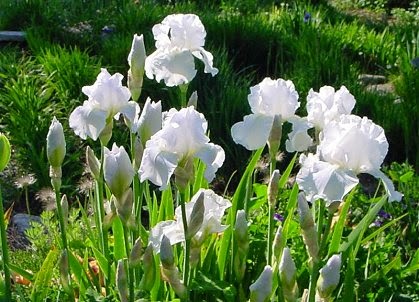by Betty Wilkerson
As I write this, I'm just coming off a spring season that was among the strangest I've seen in thirty plus years of breeding rebloomers. There have been springs with drought and springs with incessant rain. This year, spring started back in the winter. This was good, because I was able to do a lot of garden cleanup and repair before the bloom season got started. Then, the season was two to three weeks early. One positive to this was that everything bloomed out of order, with a second wave of rebloom stalks at the end of the regular season. For instance, 'Tara's Choice' is usually one of the first to bloom, but bloomed at mid to late season this year. It was good to see a few new iris faces, new seedlings, and some slightly older, but favorite faces.
Hybridizing reblooming irises can be a difficult challenge depending on your location. I'm in South Central Kentucky, zone 6. Why is this important? It's beginning to look more and more, to this hybridizer, like breeding irises in general, and rebloomers in particular, is a regional job. If you live in an area where recurring iris bloom is the norm, then perhaps you wouldn't understand how other regions of the country, the eastern US in particular, long for irises that bloom from frost to frost.
 |
| 'Tara's Choice (Wilkerson 2004) |
Although I can get tunnel vision when I'm out in the garden every day working with the irises, and making crosses, we are not thinking only of ourselves, but also the thousands of people hoping for a group of irises that will bloom from spring through fall, since many gardening people want the beauty of the iris throughout summer.
Less than half a dozen people are working toward rebloom in the colder climates, zones 5-7, and we are all in different parts of the country. It is a struggle to find cultivars that work for all of us. We have different favorites and have produced different cultivars of our own. Although many of us consult and talk among ourselves, we are each working for things that will rebloom in our own gardens, and hopefully, for others.
 |
| 'Immortality' (Zurbrigg 1990) |
For more information search through the Reblooming Iris Society @ www.rebloomingiris.com. Several of us can be found on "Reblooming Irises" and "Iris Hybridizers" on Facebook. We enjoy talking about irises in general and rebloomers specifically.






































